Cross-Cultural Management: Self-Reflection Report and Analysis
VerifiedAdded on 2021/04/19
|9
|1911
|225
Report
AI Summary
This report presents a student's self-reflection on their experience in a cross-cultural management module, focusing on a group podcast assignment concerning communication and negotiation within the context of the Daimler Chrysler merger. The reflection delves into the application of Hofstede's six-dimensional model and Trompenaars' seven dimensions of culture to understand cultural differences and their impact on organizational dynamics. The report explains the rationale behind choosing these theories, analyzes their relevance, and discusses the student's experience of working in a team, highlighting the insights gained about teamwork, project balance, and the importance of considering diverse perspectives. References supporting the analysis are also provided.

Running head: SELF-REFLECTION: CROSS CULTURAL MANAGEMENT
Self-reflection: Cross-cultural Management
Name of Student:
Name of University:
Author’s Note:
Self-reflection: Cross-cultural Management
Name of Student:
Name of University:
Author’s Note:
Paraphrase This Document
Need a fresh take? Get an instant paraphrase of this document with our AI Paraphraser
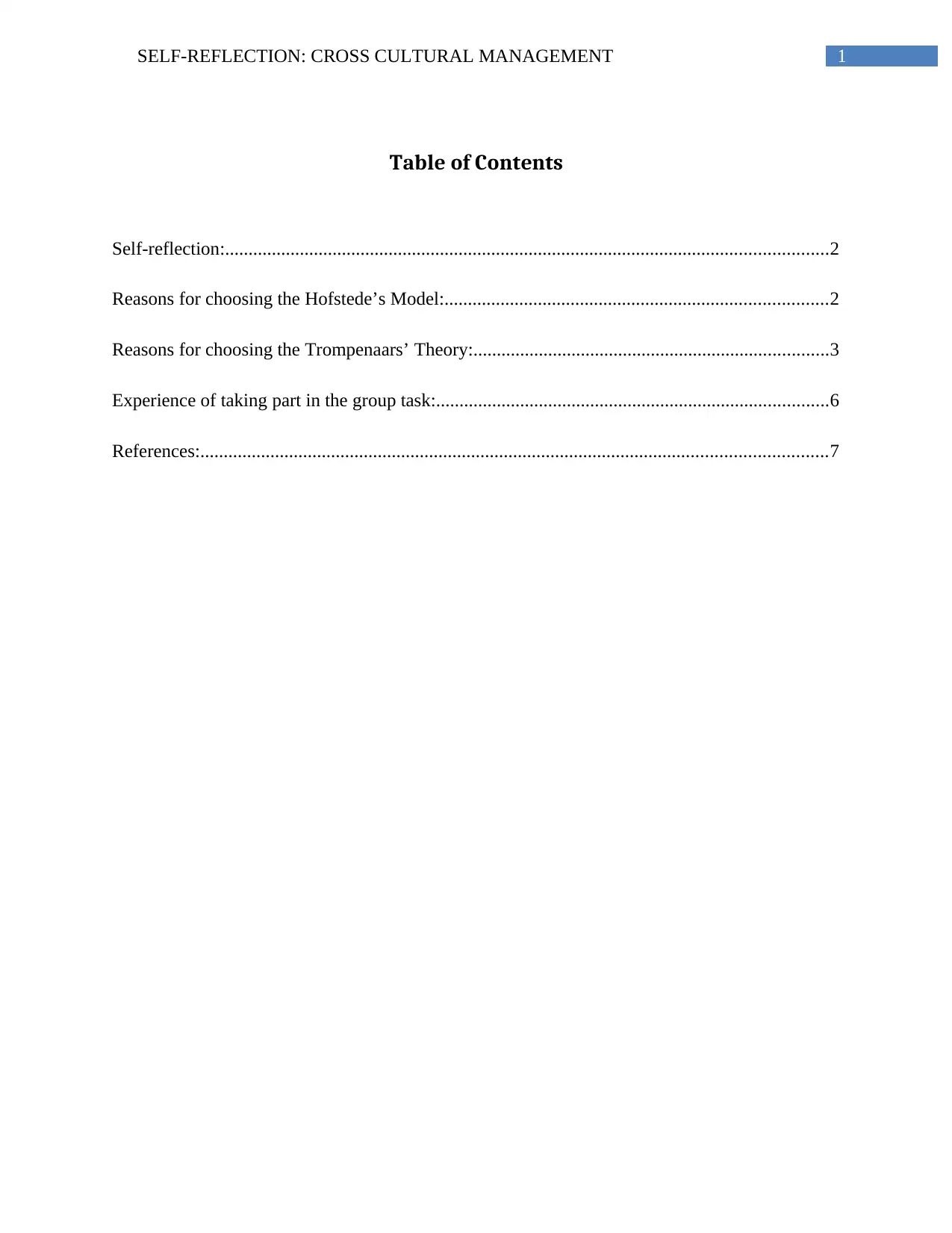
1SELF-REFLECTION: CROSS CULTURAL MANAGEMENT
Table of Contents
Self-reflection:.................................................................................................................................2
Reasons for choosing the Hofstede’s Model:..................................................................................2
Reasons for choosing the Trompenaars’ Theory:............................................................................3
Experience of taking part in the group task:....................................................................................6
References:......................................................................................................................................7
Table of Contents
Self-reflection:.................................................................................................................................2
Reasons for choosing the Hofstede’s Model:..................................................................................2
Reasons for choosing the Trompenaars’ Theory:............................................................................3
Experience of taking part in the group task:....................................................................................6
References:......................................................................................................................................7
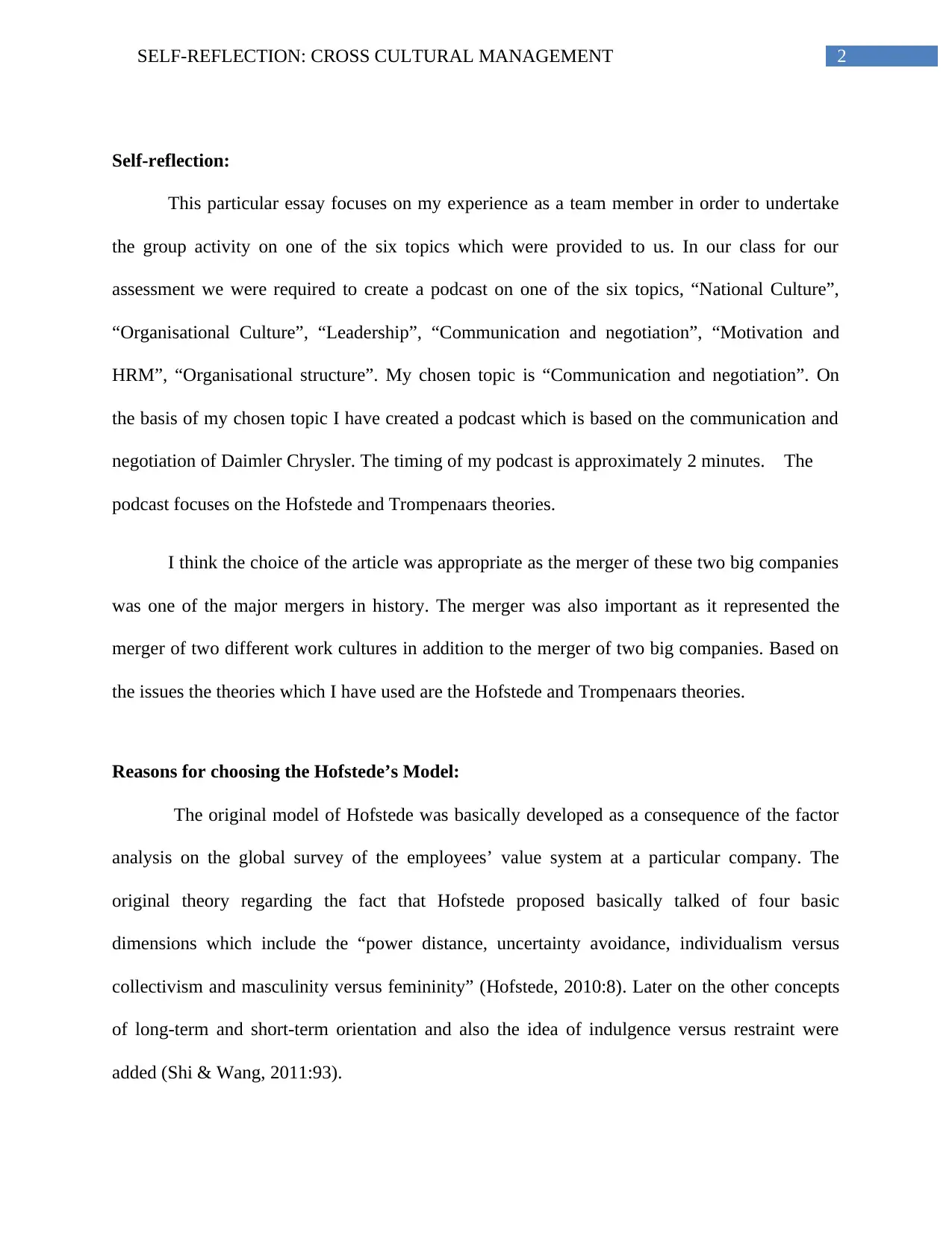
2SELF-REFLECTION: CROSS CULTURAL MANAGEMENT
Self-reflection:
This particular essay focuses on my experience as a team member in order to undertake
the group activity on one of the six topics which were provided to us. In our class for our
assessment we were required to create a podcast on one of the six topics, “National Culture”,
“Organisational Culture”, “Leadership”, “Communication and negotiation”, “Motivation and
HRM”, “Organisational structure”. My chosen topic is “Communication and negotiation”. On
the basis of my chosen topic I have created a podcast which is based on the communication and
negotiation of Daimler Chrysler. The timing of my podcast is approximately 2 minutes. The
podcast focuses on the Hofstede and Trompenaars theories.
I think the choice of the article was appropriate as the merger of these two big companies
was one of the major mergers in history. The merger was also important as it represented the
merger of two different work cultures in addition to the merger of two big companies. Based on
the issues the theories which I have used are the Hofstede and Trompenaars theories.
Reasons for choosing the Hofstede’s Model:
The original model of Hofstede was basically developed as a consequence of the factor
analysis on the global survey of the employees’ value system at a particular company. The
original theory regarding the fact that Hofstede proposed basically talked of four basic
dimensions which include the “power distance, uncertainty avoidance, individualism versus
collectivism and masculinity versus femininity” (Hofstede, 2010:8). Later on the other concepts
of long-term and short-term orientation and also the idea of indulgence versus restraint were
added (Shi & Wang, 2011:93).
Self-reflection:
This particular essay focuses on my experience as a team member in order to undertake
the group activity on one of the six topics which were provided to us. In our class for our
assessment we were required to create a podcast on one of the six topics, “National Culture”,
“Organisational Culture”, “Leadership”, “Communication and negotiation”, “Motivation and
HRM”, “Organisational structure”. My chosen topic is “Communication and negotiation”. On
the basis of my chosen topic I have created a podcast which is based on the communication and
negotiation of Daimler Chrysler. The timing of my podcast is approximately 2 minutes. The
podcast focuses on the Hofstede and Trompenaars theories.
I think the choice of the article was appropriate as the merger of these two big companies
was one of the major mergers in history. The merger was also important as it represented the
merger of two different work cultures in addition to the merger of two big companies. Based on
the issues the theories which I have used are the Hofstede and Trompenaars theories.
Reasons for choosing the Hofstede’s Model:
The original model of Hofstede was basically developed as a consequence of the factor
analysis on the global survey of the employees’ value system at a particular company. The
original theory regarding the fact that Hofstede proposed basically talked of four basic
dimensions which include the “power distance, uncertainty avoidance, individualism versus
collectivism and masculinity versus femininity” (Hofstede, 2010:8). Later on the other concepts
of long-term and short-term orientation and also the idea of indulgence versus restraint were
added (Shi & Wang, 2011:93).
⊘ This is a preview!⊘
Do you want full access?
Subscribe today to unlock all pages.

Trusted by 1+ million students worldwide

3SELF-REFLECTION: CROSS CULTURAL MANAGEMENT
The six Hofstede dimensions and understanding of countries, culture and people include
the concepts discussed as a whole. The choice for choosing the six dimensional model of
Hofstede was the fact that the concept of merger can be best explained by the Hofstede Theory
which comprises of the six dimensions mentioned above (Hofstede, Jonker & Verwaart, 2012:
79-98). The use of this theory also helps to understand the explanation of each of the factors
which have been explained clearly. In case of two organisations the power distribution might
vary as well as the delegation of important duties to the leaders. This helps form an idea about
the internal operations of the organisation. The power distance index refers to the existing
differences in the work culture as per the authority which is delegated to the workers (Hofstede,
2011:8).
Thus the adoption of the Hofstede Model made it clear that organisations have distinct
cultures of their own and in addition to this the people might have separate rules and regulations
allowed for their individual preferences. In this particular case, the German culture involves the
purpose of communication to receive as well as give instructions for the suitability (De Mooij &
Hofstede, 2010: 85-110). The difference in the cultures of the organisation and the impact of the
cultures on the mergers between two completely different cultures was a great learning
experience for me while working on this particular concept of the project as a team. It honed my
knowledge and skills related to the concept of organisational culture (Pyszka & Piłat, 2011: 113-
125).
Reasons for choosing the Trompenaars’ Theory:
The Trompenaars Theory was formulated to help in the acceptance of supervision of
cultural differences. It was found that people from diverse cultures are not only randomly
The six Hofstede dimensions and understanding of countries, culture and people include
the concepts discussed as a whole. The choice for choosing the six dimensional model of
Hofstede was the fact that the concept of merger can be best explained by the Hofstede Theory
which comprises of the six dimensions mentioned above (Hofstede, Jonker & Verwaart, 2012:
79-98). The use of this theory also helps to understand the explanation of each of the factors
which have been explained clearly. In case of two organisations the power distribution might
vary as well as the delegation of important duties to the leaders. This helps form an idea about
the internal operations of the organisation. The power distance index refers to the existing
differences in the work culture as per the authority which is delegated to the workers (Hofstede,
2011:8).
Thus the adoption of the Hofstede Model made it clear that organisations have distinct
cultures of their own and in addition to this the people might have separate rules and regulations
allowed for their individual preferences. In this particular case, the German culture involves the
purpose of communication to receive as well as give instructions for the suitability (De Mooij &
Hofstede, 2010: 85-110). The difference in the cultures of the organisation and the impact of the
cultures on the mergers between two completely different cultures was a great learning
experience for me while working on this particular concept of the project as a team. It honed my
knowledge and skills related to the concept of organisational culture (Pyszka & Piłat, 2011: 113-
125).
Reasons for choosing the Trompenaars’ Theory:
The Trompenaars Theory was formulated to help in the acceptance of supervision of
cultural differences. It was found that people from diverse cultures are not only randomly
Paraphrase This Document
Need a fresh take? Get an instant paraphrase of this document with our AI Paraphraser
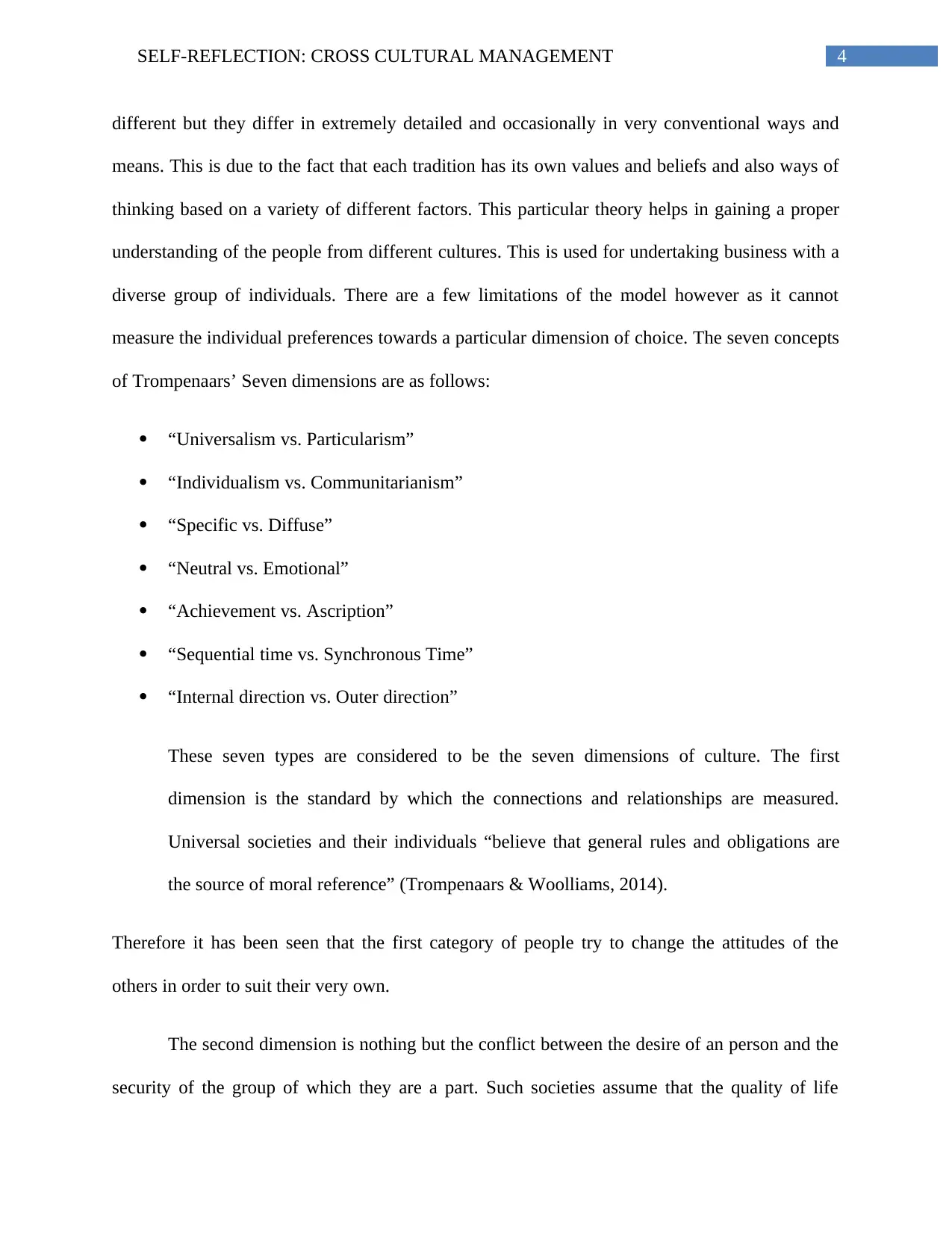
4SELF-REFLECTION: CROSS CULTURAL MANAGEMENT
different but they differ in extremely detailed and occasionally in very conventional ways and
means. This is due to the fact that each tradition has its own values and beliefs and also ways of
thinking based on a variety of different factors. This particular theory helps in gaining a proper
understanding of the people from different cultures. This is used for undertaking business with a
diverse group of individuals. There are a few limitations of the model however as it cannot
measure the individual preferences towards a particular dimension of choice. The seven concepts
of Trompenaars’ Seven dimensions are as follows:
“Universalism vs. Particularism”
“Individualism vs. Communitarianism”
“Specific vs. Diffuse”
“Neutral vs. Emotional”
“Achievement vs. Ascription”
“Sequential time vs. Synchronous Time”
“Internal direction vs. Outer direction”
These seven types are considered to be the seven dimensions of culture. The first
dimension is the standard by which the connections and relationships are measured.
Universal societies and their individuals “believe that general rules and obligations are
the source of moral reference” (Trompenaars & Woolliams, 2014).
Therefore it has been seen that the first category of people try to change the attitudes of the
others in order to suit their very own.
The second dimension is nothing but the conflict between the desire of an person and the
security of the group of which they are a part. Such societies assume that the quality of life
different but they differ in extremely detailed and occasionally in very conventional ways and
means. This is due to the fact that each tradition has its own values and beliefs and also ways of
thinking based on a variety of different factors. This particular theory helps in gaining a proper
understanding of the people from different cultures. This is used for undertaking business with a
diverse group of individuals. There are a few limitations of the model however as it cannot
measure the individual preferences towards a particular dimension of choice. The seven concepts
of Trompenaars’ Seven dimensions are as follows:
“Universalism vs. Particularism”
“Individualism vs. Communitarianism”
“Specific vs. Diffuse”
“Neutral vs. Emotional”
“Achievement vs. Ascription”
“Sequential time vs. Synchronous Time”
“Internal direction vs. Outer direction”
These seven types are considered to be the seven dimensions of culture. The first
dimension is the standard by which the connections and relationships are measured.
Universal societies and their individuals “believe that general rules and obligations are
the source of moral reference” (Trompenaars & Woolliams, 2014).
Therefore it has been seen that the first category of people try to change the attitudes of the
others in order to suit their very own.
The second dimension is nothing but the conflict between the desire of an person and the
security of the group of which they are a part. Such societies assume that the quality of life
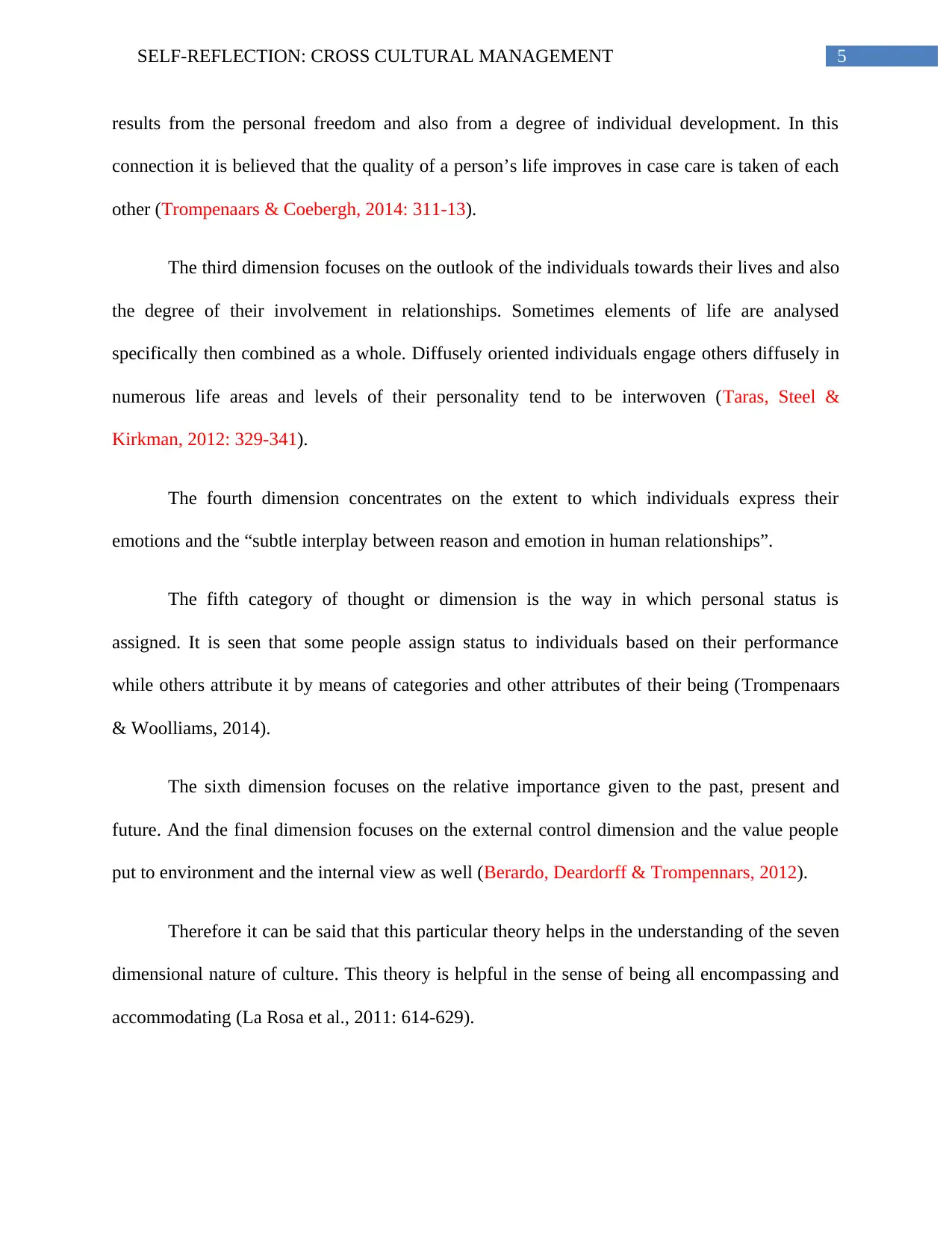
5SELF-REFLECTION: CROSS CULTURAL MANAGEMENT
results from the personal freedom and also from a degree of individual development. In this
connection it is believed that the quality of a person’s life improves in case care is taken of each
other (Trompenaars & Coebergh, 2014: 311-13).
The third dimension focuses on the outlook of the individuals towards their lives and also
the degree of their involvement in relationships. Sometimes elements of life are analysed
specifically then combined as a whole. Diffusely oriented individuals engage others diffusely in
numerous life areas and levels of their personality tend to be interwoven (Taras, Steel &
Kirkman, 2012: 329-341).
The fourth dimension concentrates on the extent to which individuals express their
emotions and the “subtle interplay between reason and emotion in human relationships”.
The fifth category of thought or dimension is the way in which personal status is
assigned. It is seen that some people assign status to individuals based on their performance
while others attribute it by means of categories and other attributes of their being (Trompenaars
& Woolliams, 2014).
The sixth dimension focuses on the relative importance given to the past, present and
future. And the final dimension focuses on the external control dimension and the value people
put to environment and the internal view as well (Berardo, Deardorff & Trompennars, 2012).
Therefore it can be said that this particular theory helps in the understanding of the seven
dimensional nature of culture. This theory is helpful in the sense of being all encompassing and
accommodating (La Rosa et al., 2011: 614-629).
results from the personal freedom and also from a degree of individual development. In this
connection it is believed that the quality of a person’s life improves in case care is taken of each
other (Trompenaars & Coebergh, 2014: 311-13).
The third dimension focuses on the outlook of the individuals towards their lives and also
the degree of their involvement in relationships. Sometimes elements of life are analysed
specifically then combined as a whole. Diffusely oriented individuals engage others diffusely in
numerous life areas and levels of their personality tend to be interwoven (Taras, Steel &
Kirkman, 2012: 329-341).
The fourth dimension concentrates on the extent to which individuals express their
emotions and the “subtle interplay between reason and emotion in human relationships”.
The fifth category of thought or dimension is the way in which personal status is
assigned. It is seen that some people assign status to individuals based on their performance
while others attribute it by means of categories and other attributes of their being (Trompenaars
& Woolliams, 2014).
The sixth dimension focuses on the relative importance given to the past, present and
future. And the final dimension focuses on the external control dimension and the value people
put to environment and the internal view as well (Berardo, Deardorff & Trompennars, 2012).
Therefore it can be said that this particular theory helps in the understanding of the seven
dimensional nature of culture. This theory is helpful in the sense of being all encompassing and
accommodating (La Rosa et al., 2011: 614-629).
⊘ This is a preview!⊘
Do you want full access?
Subscribe today to unlock all pages.

Trusted by 1+ million students worldwide
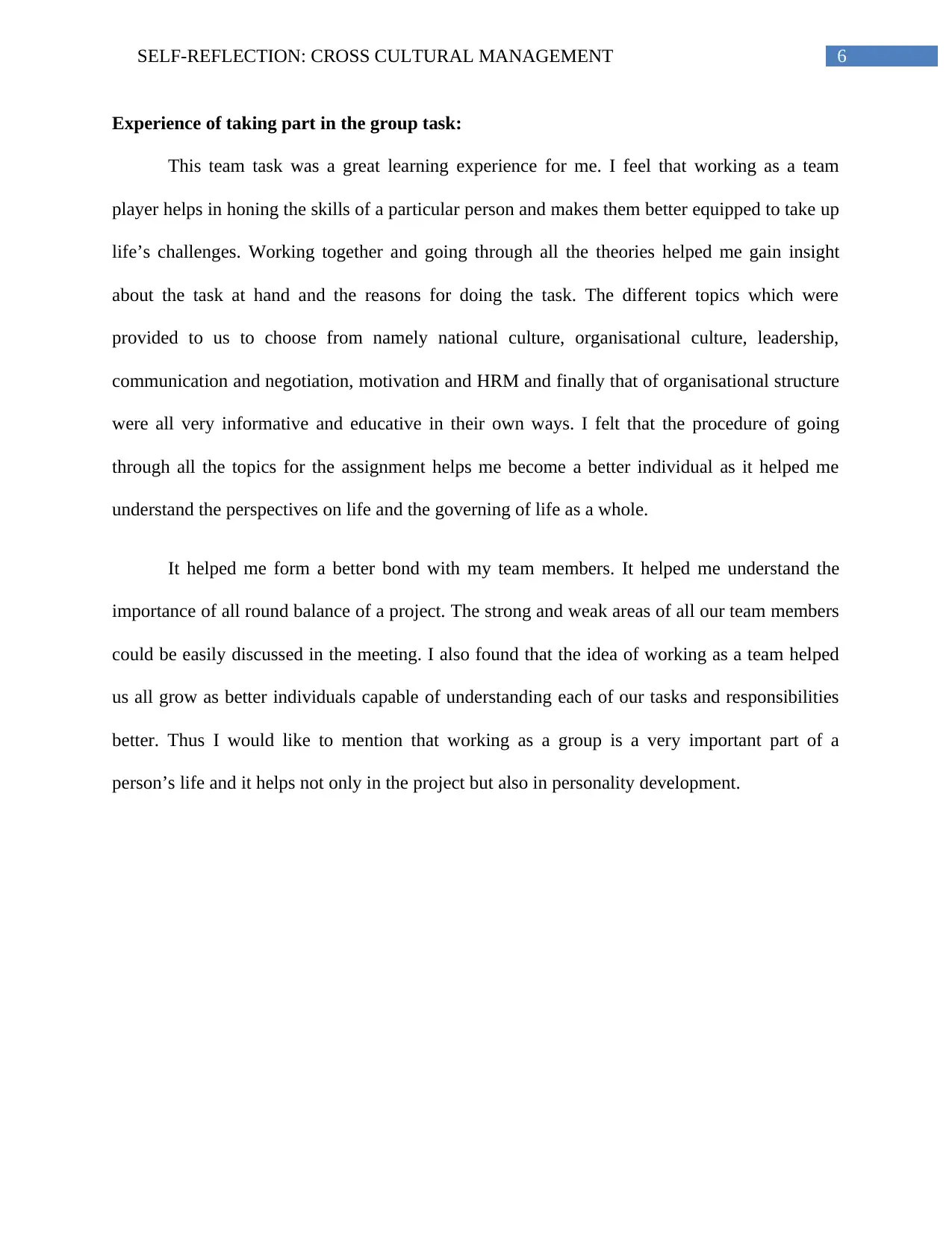
6SELF-REFLECTION: CROSS CULTURAL MANAGEMENT
Experience of taking part in the group task:
This team task was a great learning experience for me. I feel that working as a team
player helps in honing the skills of a particular person and makes them better equipped to take up
life’s challenges. Working together and going through all the theories helped me gain insight
about the task at hand and the reasons for doing the task. The different topics which were
provided to us to choose from namely national culture, organisational culture, leadership,
communication and negotiation, motivation and HRM and finally that of organisational structure
were all very informative and educative in their own ways. I felt that the procedure of going
through all the topics for the assignment helps me become a better individual as it helped me
understand the perspectives on life and the governing of life as a whole.
It helped me form a better bond with my team members. It helped me understand the
importance of all round balance of a project. The strong and weak areas of all our team members
could be easily discussed in the meeting. I also found that the idea of working as a team helped
us all grow as better individuals capable of understanding each of our tasks and responsibilities
better. Thus I would like to mention that working as a group is a very important part of a
person’s life and it helps not only in the project but also in personality development.
Experience of taking part in the group task:
This team task was a great learning experience for me. I feel that working as a team
player helps in honing the skills of a particular person and makes them better equipped to take up
life’s challenges. Working together and going through all the theories helped me gain insight
about the task at hand and the reasons for doing the task. The different topics which were
provided to us to choose from namely national culture, organisational culture, leadership,
communication and negotiation, motivation and HRM and finally that of organisational structure
were all very informative and educative in their own ways. I felt that the procedure of going
through all the topics for the assignment helps me become a better individual as it helped me
understand the perspectives on life and the governing of life as a whole.
It helped me form a better bond with my team members. It helped me understand the
importance of all round balance of a project. The strong and weak areas of all our team members
could be easily discussed in the meeting. I also found that the idea of working as a team helped
us all grow as better individuals capable of understanding each of our tasks and responsibilities
better. Thus I would like to mention that working as a group is a very important part of a
person’s life and it helps not only in the project but also in personality development.
Paraphrase This Document
Need a fresh take? Get an instant paraphrase of this document with our AI Paraphraser
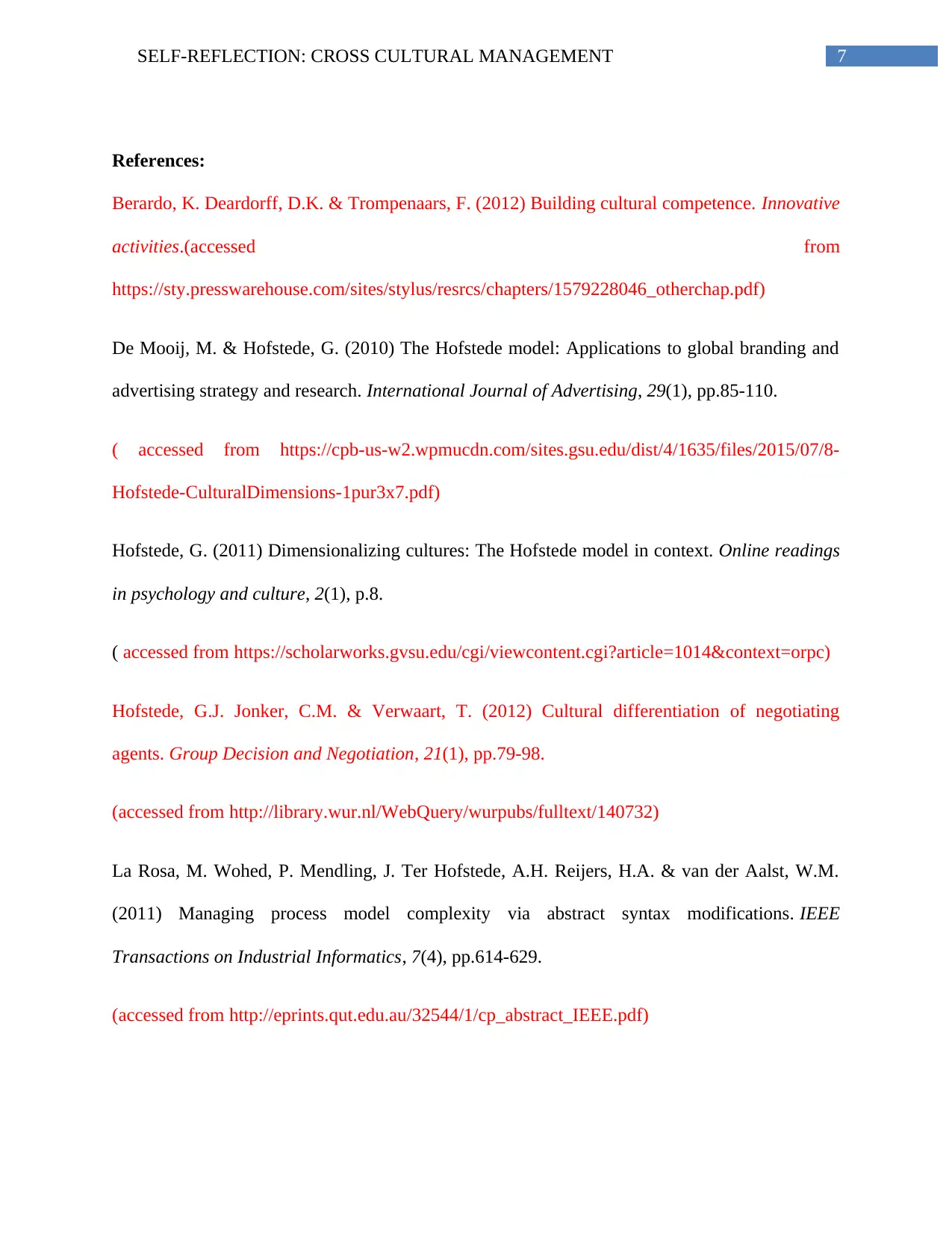
7SELF-REFLECTION: CROSS CULTURAL MANAGEMENT
References:
Berardo, K. Deardorff, D.K. & Trompenaars, F. (2012) Building cultural competence. Innovative
activities.(accessed from
https://sty.presswarehouse.com/sites/stylus/resrcs/chapters/1579228046_otherchap.pdf)
De Mooij, M. & Hofstede, G. (2010) The Hofstede model: Applications to global branding and
advertising strategy and research. International Journal of Advertising, 29(1), pp.85-110.
( accessed from https://cpb-us-w2.wpmucdn.com/sites.gsu.edu/dist/4/1635/files/2015/07/8-
Hofstede-CulturalDimensions-1pur3x7.pdf)
Hofstede, G. (2011) Dimensionalizing cultures: The Hofstede model in context. Online readings
in psychology and culture, 2(1), p.8.
( accessed from https://scholarworks.gvsu.edu/cgi/viewcontent.cgi?article=1014&context=orpc)
Hofstede, G.J. Jonker, C.M. & Verwaart, T. (2012) Cultural differentiation of negotiating
agents. Group Decision and Negotiation, 21(1), pp.79-98.
(accessed from http://library.wur.nl/WebQuery/wurpubs/fulltext/140732)
La Rosa, M. Wohed, P. Mendling, J. Ter Hofstede, A.H. Reijers, H.A. & van der Aalst, W.M.
(2011) Managing process model complexity via abstract syntax modifications. IEEE
Transactions on Industrial Informatics, 7(4), pp.614-629.
(accessed from http://eprints.qut.edu.au/32544/1/cp_abstract_IEEE.pdf)
References:
Berardo, K. Deardorff, D.K. & Trompenaars, F. (2012) Building cultural competence. Innovative
activities.(accessed from
https://sty.presswarehouse.com/sites/stylus/resrcs/chapters/1579228046_otherchap.pdf)
De Mooij, M. & Hofstede, G. (2010) The Hofstede model: Applications to global branding and
advertising strategy and research. International Journal of Advertising, 29(1), pp.85-110.
( accessed from https://cpb-us-w2.wpmucdn.com/sites.gsu.edu/dist/4/1635/files/2015/07/8-
Hofstede-CulturalDimensions-1pur3x7.pdf)
Hofstede, G. (2011) Dimensionalizing cultures: The Hofstede model in context. Online readings
in psychology and culture, 2(1), p.8.
( accessed from https://scholarworks.gvsu.edu/cgi/viewcontent.cgi?article=1014&context=orpc)
Hofstede, G.J. Jonker, C.M. & Verwaart, T. (2012) Cultural differentiation of negotiating
agents. Group Decision and Negotiation, 21(1), pp.79-98.
(accessed from http://library.wur.nl/WebQuery/wurpubs/fulltext/140732)
La Rosa, M. Wohed, P. Mendling, J. Ter Hofstede, A.H. Reijers, H.A. & van der Aalst, W.M.
(2011) Managing process model complexity via abstract syntax modifications. IEEE
Transactions on Industrial Informatics, 7(4), pp.614-629.
(accessed from http://eprints.qut.edu.au/32544/1/cp_abstract_IEEE.pdf)
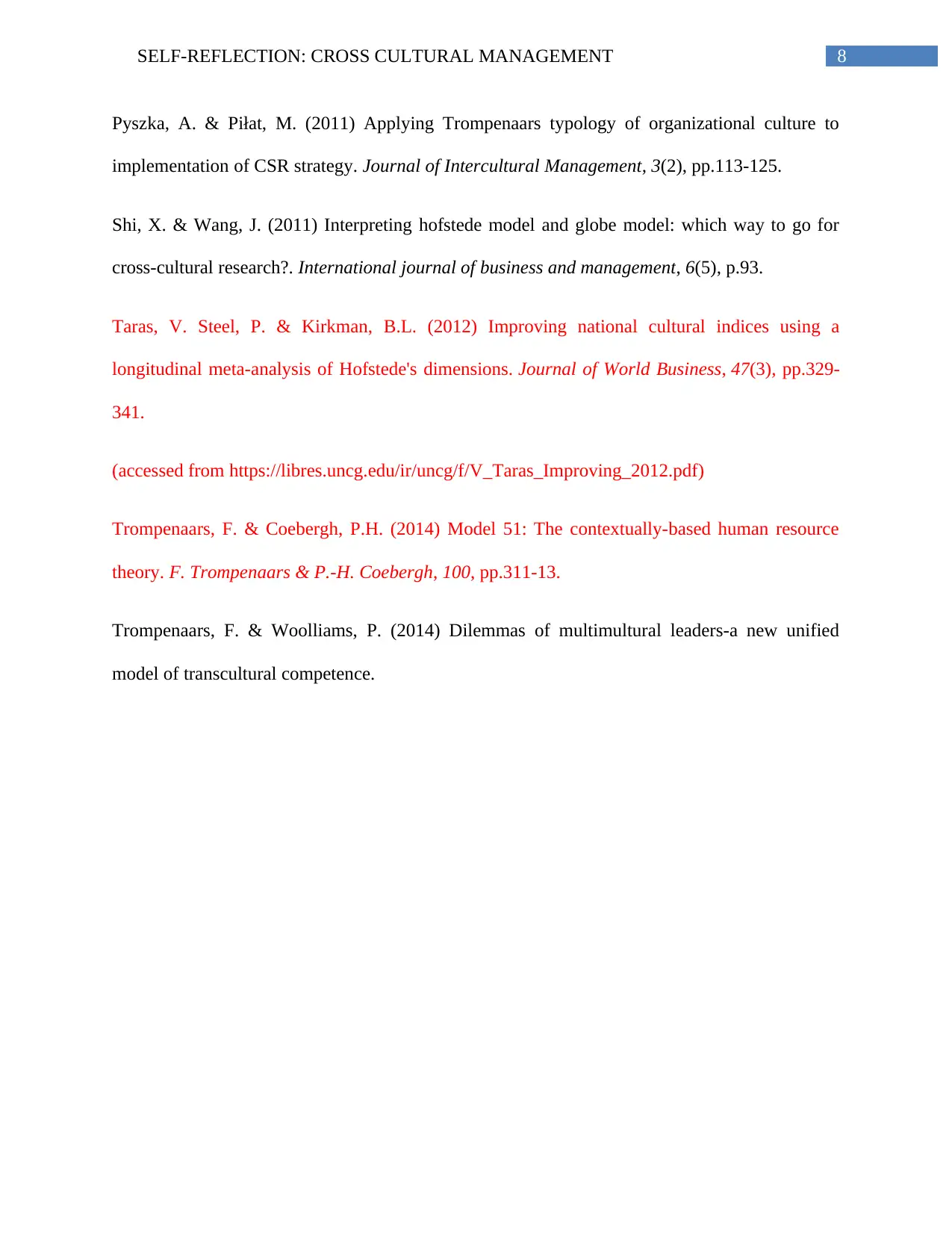
8SELF-REFLECTION: CROSS CULTURAL MANAGEMENT
Pyszka, A. & Piłat, M. (2011) Applying Trompenaars typology of organizational culture to
implementation of CSR strategy. Journal of Intercultural Management, 3(2), pp.113-125.
Shi, X. & Wang, J. (2011) Interpreting hofstede model and globe model: which way to go for
cross-cultural research?. International journal of business and management, 6(5), p.93.
Taras, V. Steel, P. & Kirkman, B.L. (2012) Improving national cultural indices using a
longitudinal meta-analysis of Hofstede's dimensions. Journal of World Business, 47(3), pp.329-
341.
(accessed from https://libres.uncg.edu/ir/uncg/f/V_Taras_Improving_2012.pdf)
Trompenaars, F. & Coebergh, P.H. (2014) Model 51: The contextually-based human resource
theory. F. Trompenaars & P.-H. Coebergh, 100, pp.311-13.
Trompenaars, F. & Woolliams, P. (2014) Dilemmas of multimultural leaders-a new unified
model of transcultural competence.
Pyszka, A. & Piłat, M. (2011) Applying Trompenaars typology of organizational culture to
implementation of CSR strategy. Journal of Intercultural Management, 3(2), pp.113-125.
Shi, X. & Wang, J. (2011) Interpreting hofstede model and globe model: which way to go for
cross-cultural research?. International journal of business and management, 6(5), p.93.
Taras, V. Steel, P. & Kirkman, B.L. (2012) Improving national cultural indices using a
longitudinal meta-analysis of Hofstede's dimensions. Journal of World Business, 47(3), pp.329-
341.
(accessed from https://libres.uncg.edu/ir/uncg/f/V_Taras_Improving_2012.pdf)
Trompenaars, F. & Coebergh, P.H. (2014) Model 51: The contextually-based human resource
theory. F. Trompenaars & P.-H. Coebergh, 100, pp.311-13.
Trompenaars, F. & Woolliams, P. (2014) Dilemmas of multimultural leaders-a new unified
model of transcultural competence.
⊘ This is a preview!⊘
Do you want full access?
Subscribe today to unlock all pages.

Trusted by 1+ million students worldwide
1 out of 9
Related Documents
Your All-in-One AI-Powered Toolkit for Academic Success.
+13062052269
info@desklib.com
Available 24*7 on WhatsApp / Email
![[object Object]](/_next/static/media/star-bottom.7253800d.svg)
Unlock your academic potential
Copyright © 2020–2025 A2Z Services. All Rights Reserved. Developed and managed by ZUCOL.




